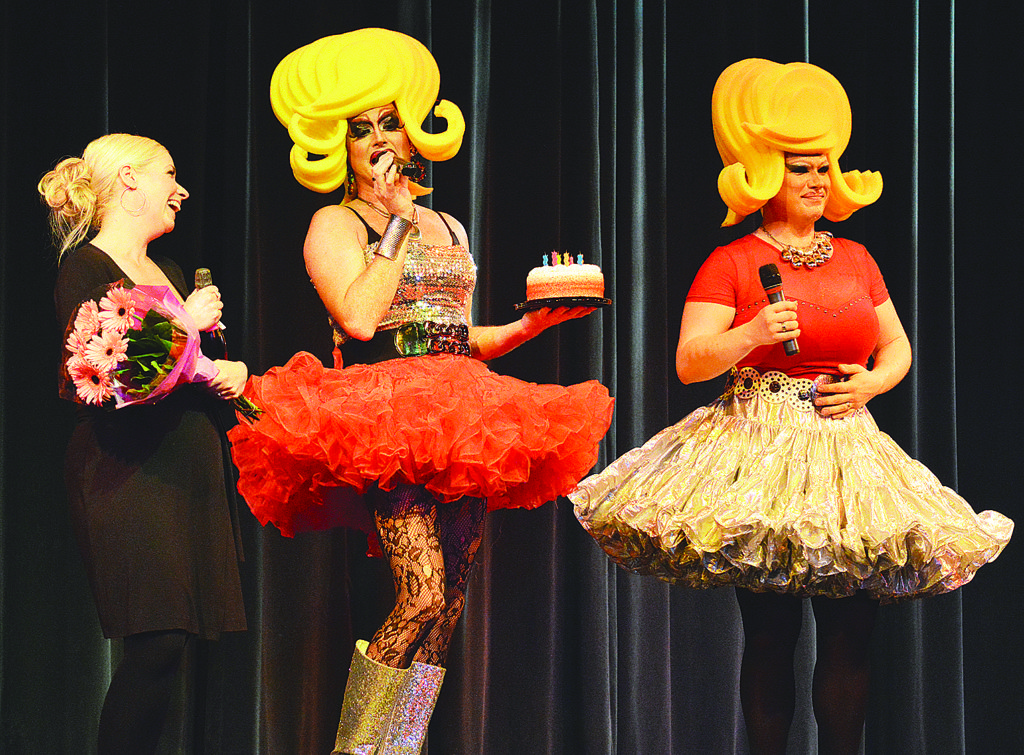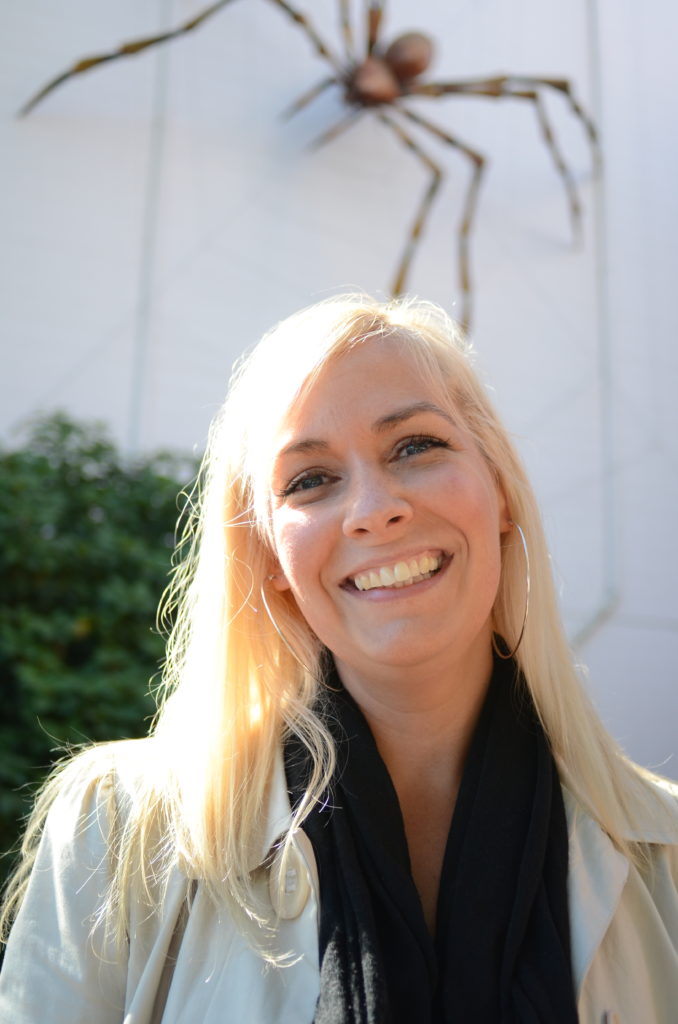For someone who admits she has trouble drawing even the most simple of stick figures, Heidi Cuff has certainly embedded herself pretty deeply in the Campbell River arts scene since her arrival in our little city seven years ago.
Cuff is the marketing and programming director for the Tidemark Theatre Society, she sits on the board of directors for the Campbell River Art Gallery and has recently joined up with the Campbell River Arts Council to help with administering their programming, as well.
She sure took that proverbial long and winding road to get there, though.
Cuff grew up in “Cottage Country,” as most people in Ontario call it. She just called it “home.”
Her life was full of music and dance and theatre and love.
“Both of my parents were musicians and artists,” Cuff says. “My mom was actually an art teacher. They met playing in a band,” she adds with a laugh.
Her mother was also active in the local community theatre.
Her aunt worked in the music department at the University of Toronto.
Her grandmother taught piano lessons to the neighbourhood children when Cuff was growing up.
“So I guess you could say it was just very much a part of my upbringing. It was always just there.”
She joined every theatre troupe she could throughout her childhood and got involved with every production she could find time for. You might say she was the stereotypical “theatre geek.”
And while she wouldn’t say she was discouraged from finding a path within the arts – her parents, like all parents, would have been supportive of whatever career path she chose – she does admit, “it was kind of drilled into me when I was young that I was probably going to have to, at some point, find a real job,” she says with a laugh. “That the arts as a hobby was great, but that I should probably look into something more lucrative as a career.”
Which led to her enrollment in the social work program at Canadore College in North Bay, Ontario.
Wait – wasn’t she supposed to take something lucrative?
“Yeah, well, I think somewhere in the back of my mind my hope was that eventually, somehow, I could incorporate the arts into some facet of therapy or other social benefit, because I’d seen throughout my life how the arts could make a difference in people’s lives in terms of giving them an outlet – giving them some hope or courage or, you know, even just somewhere to vent.”
You see, Cuff had been heavily invested in the production of a program through her high school in Huntsville called the Black Hole Cabaret, where students could come and put on performances in various genres as an outlet for their creativity, “and what struck me about that experience was that a lot of kids who were having problems or came from broken homes or abusive situation could really shine through this. They received so much love and support and encouragement through the artistic community, and because of that, they were able to pull themselves out of addiction – or gave them the strength that was needed to get through their problem, whatever it happened to be.
“So,” she continues, “if I wasn’t going into the arts, I thought maybe I could go into social work or psychology or something and incorporate the arts into helping people heal.”
She ended up leaving the social work program, however, after speaking with some of her professors about the emotional impact some of the work was having on her.
“I was asking them about some of the stuff we were having to deal with in our practicums, and how I was taking a lot of that home, emotionally, and I wasn’t sure I could handle doing that as a career,” Cuff says. “I guess I’m a bit sensitive, and a couple of my professors were very honest and said they thought I’d probably be very good at it, but that I would also probably burn out after five or ten years if I was already, you know, crying myself to sleep at night and I’m not even really in the field yet.”
She had a friend in California, “who needed a roommate,” she says with a shrug, as if it was the most natural decision in the world.
And so she’d moved, over the course of a decade or so, from stereotypical high-school theatre geek to stereotypical out-of-work actor bumming around L.A. going to auditions and not getting any roles.
“I worked some really crappy jobs working the circuit down there,” she says with yet another laugh, “and after a while, I got tired of going out for auditions and trying to make a go of it and not getting anywhere, so I decided to go back to school again.”
She got back into an undergraduate program in psychology, and was again directed by her professors to follow her passions instead.
“They didn’t have a theatre major, so I became a communications studies major with a minor in theatre.”
Upon graduation, she got on with another community theatre program down there in California, and was pretty excited about how her life was turning out, but she also had a hankering for more education, as well.
“I knew I wanted to go on and get my masters in Educational Theatre, and there were only two programs that offered it: Arizona and NYU,” she says.
Since she had done her communications internship with Atlantic Records in New York, she thought NYU made more, which was perfect, because she was told they reject people a couple of times before admitting them, and she really wasn’t ready to leave what she was doing just yet.
Too bad, Cuff. Life just doesn’t work that way.
She got in on her first application and moved to New York City six months after 9-11.
“It was a pretty intense time to move there,” she says. “But I started my Educational Theatre degree at NYU and I was there for six years, and didn’t think I was going to leave.”
Too bad again, Cuff.
“But then I reconnected with my now-husband, who was actually my very first boyfriend in high school, and he was out here. Once we decided we were going to start a family, we came to visit his mom, who was out here, and I fell in love with the Island.”
Once she arrived with her newly-forming family in Campbell River, she needed a job. And she wanted it to be in the arts, obviously.
“I fell in love with Campbell River when I first got here because there is such a thriving artistic community here, but as I was starting to call around to the various arts organizations, it became very clear that once people had those those really awesome arts jobs, they didn’t let go,” she says, exploding with that same contagious laugh again.
But she kept at it, and eventually applied for a ticket centre position at the Tidemark.
“And I went for an interview, and the managing director and president at that time decided, after looking at my resume, that maybe I was overqualified for a ticket centre position, and they created a role for me, which was wonderful.”
So she was put in charge of the theatre’s children’s programming, which led to her being put in charge of the theatre’s programming, which led to her being put in charge of the theatre’s communications and marketing, too.
But she wanted more. There was only so much she could do at the theatre to further the proliferation and appreciation of the arts within her new community, which she now called home. Her role on the board of the art gallery was a natural next step, Cuff says.
“Because they are our neighbour and we work with them on the ReelArt Film Festival and a number of other initiatives, it just made sense to accept that invitation when it was offered,” she says. “I love art. I wish I was an artist, but I appreciate it and I love being surrounded by it.”
And so, continuing to surround herself with art, she then also accepted an administrative position with the Campbell River Arts Council, as well.

by Isolde N. Barron (centre) and Peach Cobblah (right).
Barron and Cobblah thanked Cuff for being instrumental in bringing the Queens, Kings and Things drag talent show to the Tidemark Theatre.
Executive director Ken Blackburn says he’s excited to have Cuff on board. “One of the really positive things about Heidi joining the Arts Council,” Blackburn says, “is that she’s very much community engaged through her role at the Tidemark. That’s something that I’ve come to really appreciate in town, because my career here has also been very much split between two organizations.”
Blackburn also serves as director of public programs at the Museum at Campbell River.
“The overlap and interconnections have been of benefit to both, I think,” Blackburn says. “I’ve been able to bring resources and contacts to both organizations. There’s a synergy. And Heidi brings more of that synergy with her, which is great. The interconnectivity between entities within any sector becomes key when looking at community development, whether they be economic, social or cultural sectors,” Blackburn continues. “To have her come on here at the arts council, and bring with her the extensive community contacts and networks she’s got through the Tidemark, you’ve now got the museum and the Tidemark both intersecting through here, and it really starts to become a good model for how sectors can interweave and grow together.”
“I like how the arts council is kind of like the umbrella – or connecting factor – between the arts organizations in the community,” Cuff says.
“I’m excited to get started there and build on what Ken and the board has been building over the past few years and see where we can make this community go in terms of arts programming and furthering the dynamic of the arts as an integral factor within the lives of the people.”
